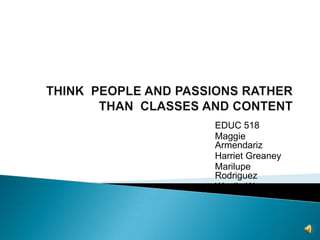Chapter%203
•Télécharger en tant que PPTX, PDF•
0 j'aime•342 vues
Signaler
Partager
Signaler
Partager

Recommandé
Contenu connexe
Tendances
Tendances (20)
En vedette
En vedette (7)
Similaire à Chapter%203
Slides used in the workshop.Leading and Building the Adaptive School - Master Class, Australian Primary P...

Leading and Building the Adaptive School - Master Class, Australian Primary P...Stephen Murgatroyd, PhD FBPsS FRSA
Similaire à Chapter%203 (20)
Leading and Building the Adaptive School - Master Class, Australian Primary P...

Leading and Building the Adaptive School - Master Class, Australian Primary P...
Differentiated Instruction Presentacion In Service Training 2009

Differentiated Instruction Presentacion In Service Training 2009
Faith Ward - Differentiation: Supporting All Learners in the School Library

Faith Ward - Differentiation: Supporting All Learners in the School Library
Teaching-Learning Philosophy Statement_Rachel Eike

Teaching-Learning Philosophy Statement_Rachel Eike
Inquiry cycle- A tool for co-construction of contexual and conceptual underst...

Inquiry cycle- A tool for co-construction of contexual and conceptual underst...
Plus de jhtrespa
Plus de jhtrespa (15)
Non experimental%20 quantitative%20research%20designs-1

Non experimental%20 quantitative%20research%20designs-1
Dernier
Dernier (20)
Presentation by Andreas Schleicher Tackling the School Absenteeism Crisis 30 ...

Presentation by Andreas Schleicher Tackling the School Absenteeism Crisis 30 ...
Unit-V; Pricing (Pharma Marketing Management).pptx

Unit-V; Pricing (Pharma Marketing Management).pptx
Ecological Succession. ( ECOSYSTEM, B. Pharmacy, 1st Year, Sem-II, Environmen...

Ecological Succession. ( ECOSYSTEM, B. Pharmacy, 1st Year, Sem-II, Environmen...
Z Score,T Score, Percential Rank and Box Plot Graph

Z Score,T Score, Percential Rank and Box Plot Graph
Measures of Dispersion and Variability: Range, QD, AD and SD

Measures of Dispersion and Variability: Range, QD, AD and SD
This PowerPoint helps students to consider the concept of infinity.

This PowerPoint helps students to consider the concept of infinity.
Basic Civil Engineering first year Notes- Chapter 4 Building.pptx

Basic Civil Engineering first year Notes- Chapter 4 Building.pptx
Python Notes for mca i year students osmania university.docx

Python Notes for mca i year students osmania university.docx
On National Teacher Day, meet the 2024-25 Kenan Fellows

On National Teacher Day, meet the 2024-25 Kenan Fellows
ICT role in 21st century education and it's challenges.

ICT role in 21st century education and it's challenges.
Russian Escort Service in Delhi 11k Hotel Foreigner Russian Call Girls in Delhi

Russian Escort Service in Delhi 11k Hotel Foreigner Russian Call Girls in Delhi
Energy Resources. ( B. Pharmacy, 1st Year, Sem-II) Natural Resources

Energy Resources. ( B. Pharmacy, 1st Year, Sem-II) Natural Resources
Asian American Pacific Islander Month DDSD 2024.pptx

Asian American Pacific Islander Month DDSD 2024.pptx
Chapter%203
- 1. THINK PEOPLE AND PASSIONS RATHER THAN CLASSES AND CONTENT EDUC 518 Maggie Armendariz Harriet Greaney Marilupe Rodriguez Wenjie Wang
- 2. A key aspect of “partnering” education is discovering students’ passions and interests. Today’s teachers need to help students discover, understand, and develop their passions. WHAT ARE STUDENTS’ PASSIONS?
- 3. LEARN ABOUT YOUR STUDENTS’ INTERESTS AND PASSIONS While partnering, it is important to know students’ passions in detail. Passion provides a source of energy that inspires learners to make an effort, determines how long they will be willing to endure an activity, how hard they will pursue it, and how much they learn.
- 4. Passion, in this sense, means a person’s central goals in life, the things the learner cares about most, or the things that move him or her emotionally. This does not mean that a student needs to become passionate about learning English in order to succeed. Rather, the student needs to find a way to connect English learning to his passionate interests. WHY LEARN ABOUT STUDENTS’ PASSIONS?
- 5. Each student learns differently. As partners and educators, we find that students are talented in different ways. One student may be creative, another analytical;or one may be mechanical, and another may excel at writing. Teaching requires differentiated and individualized instruction. We use passions as the drivers of student engagement and achievement. INDIVIDUALIZE INTRUCTION DAILY
- 6. Educators can learn from their students by helping them find their passions and by organizing class activities around the theme of self-expression. To discover students’ passions, educators can use various methods--personalized tasks, idea journals, speaking circles, or interactive questionnaires. LEARN FROM YOUR STUDENTS
- 7. HOW CAN WE USE PASSIONS? To build respect and tolerance for individuality. To inspire more variety in our lessons. To allow us to create meaningful guiding questions. To encourage us to get and give constant feedback.
- 10. Researcher Technology expert Thinker World changer Self- teacher “Professional” STUDENTS’ ROLES
- 11. Encourage variations in team work and peer- to- peer learning. Address slacker-free group work. Hold class discussions Circle the chairs. Use students as assistants. MORE IDEAS
- 12. The more we educators think of students as individuals with their own passions, the more we use those passions to instruct and motivate, and the more we will reach all students. Students will be more motivated to take advantage of opportunities and to display greater effort and concentration. Students will reveal positive emotions such as excitement, enthusiasm, interest, and optimism during learning. CONCLUSIONS
- 13. Prensky, M. (2010). Teaching digital natives: Partnering for real learning. Thousand Oaks, CA: Corwin a Sage Company. REFERENCE